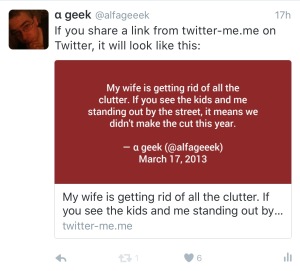I wrote another web app. I’m friends with a bunch of “branded” Twitter comedians. And they were complaining about people “meme-ing” their tweets. That is, making a picture with their words on it. More often than not, these nefarious people omit attribution (so it’s just plagiarism), put their own branding on it (fuckers), and put it on Facebook where it gets tens of thousands of thumbs-up. That sucks, and it makes my friends mad.
So we were talking about it, and I noted that Twitter isn’t helping matters. If you share a link to a tweet on Facebook, it looks awful. You’ll get a super-blown-up picture of the person’s AVI and only part of the tweet. Nobody is going to put that hot mess on their Facebook. And while it’s unlikely we can get Twitter or Facebook to improve that situation, it seemed to me that it would be pretty easy for an intermediary to improve things quite a bit.
So I wrote an app. twitter-me.me
It’s like Twitter Meme, get it? You put a tweet link into it, and it turns it into a nice picture. Originally, just white words on a dark blue background. Although I’ve since updated it to give you a choice of colors and fonts and layouts. And it gives you a new link, which is really just the link you started with, except you put “http://twitter-me.me” in place of “https://twitter.com”. (Supporting https is absurdly expensive for a free app, so I’m not doing that until there’s a robust way to do https for free.)

Tweet shared as a picture on Facebook
When you share a link on Facebook, it goes and looks at the web page to find the title and description and picture. I set up the app so that when Facebook looks at that link, it gets the @ of the person who tweeted it as a title, the tweet itself as the description, and the picture of your words as the picture. You don’t need to do anything special. Just share that link and it looks great.
If somebody uses a browser to view the link, though, it serves up a “redirect” that just takes you right to the tweet. So the result is that if someone clicks on that picture, they end up on the tweet and and can like it or retweet it or follow you or whatever.

Tweet shared as a picture on tumblr
That part was actually pretty easy. So then someone asked me if I could make the same thing happen with tumblr. Remember tumblr? It’s where the porn was until Yahoo! bought it. Anyway, some people still use it, and one of them was wondering if they could share these tweet-pictures there. Tumblr has a “share” button that makes it easy to share a picture, but there is no option on it to include a link. You can have a link attached to a picture. But you’d have to go manually set it up, which is a drag.
So I dug deeper and found that tumblr has an API, so other web applications can post to tumblr on behalf of a user. So after spending some time fighting with that, I managed to implement a tumblr share button that works just like Facebook. You share the tweet to your blog, and it looks nice and if the viewer clicks it, they end up at the tweet.

Tweet shared as a picture on Twitter
So the next thing that happened was someone asked if they could share the picture on Twitter. Why would you want to share a picture of a tweet on Twitter, instead of just RT’ing the tweet itself? Beats me. But it was super easy, so I did it anyway. Twitter works the same way Facebook does when you share a link. It goes to that URL and sees what kind of a preview it can generate. I just had to recognize that “twitterbot” was looking at the link, and in that case serve up some special tags that let it know to show a nice picture.
So now you can take your tweet, make it look nice as a picture, and share it on Facebook, tumblr, and Twitter. I don’t think there’s any way to get Instagram in on this, because they don’t let you attach a link to a picture. And making pictures that link back to the tweet is kind of the whole point. But I’m open to suggestions.
I also made a page where you can see the most popular (based on click-through counts) of these image: twitter-me.me/browse Each one has a button to let you share it to your Facebook or tumblr accounts. If this takes off and lots of people start making these, I’ll probably add more features to that, like viewing “trending” or “newest” or whatever. Right now, I just show the top 20, like a leader board.
I’m hosting this in Google App Engine, which has pretty decent free quotas. So it isn’t costing me anything (except a few bucks for the domain name). If it really takes off, and I can’t run it for free any more, I’ll figure out some painless way to monetize it. But in my experience, things usually don’t take off. So it’ll probably just remain a free service my friends can use to put their tweets on Facebook. And I’m perfectly happy with that.
Ironically, I can’t use it myself, because I don’t want Facebook people to know about my Twitter account.